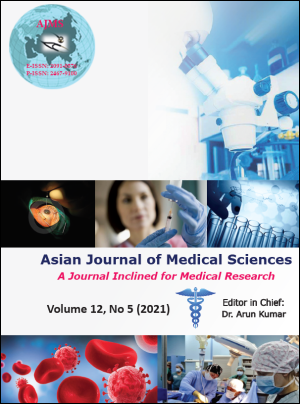The effect of serum insulin on the blood pressure responses after oral glucose load in lean and centrally obese adult male subjects
Keywords:
serum insulin, Blood pressure responses, Oral glucose load, Centrally obeseAbstract
Background: The vasodilator action of insulin might contribute to the reduction of blood pressure in the postprandial state and it remains to be clarified whether this action is impaired in the insulin- resistant obese state or not.
Aims and Objective: The present study aimed to determine the blood pressure responses after an oral glucose load in lean and insulin resistant centrally obese adult male subjects.
Materials and Methods: This study was carried out in eleven lean and eleven centrally obese adult male subjects. After a 75 g oral glucose load, blood pressures were measured at 15-minute intervals and the serum insulin level was determined at 30-minute intervals for two hours. Blood pressure was measured by indirect sphygmomanometry and serum insulin concentration was analyzed by ELISA method.
Results: All centrally obese subjects were insulin resistant (HOMA-IR≥2.6). After oral glucose load, the per cent change in glucose-stimulated insulin responses at 30 minutes (626% vs 344%, p<0.05) and at 60 minutes (756% vs 417%, p<0.01) were significantly greater in the lean group than the centrally obese group. The fall in postprandial blood pressures started at 15 minutes and returned to baseline values at 120 minutes. The per cent change in SBP at 15 minutes (-2.2% vs -1.2%, p<0.05) and at 30 minutes (-3.2% vs -2.1%, p<0.05) were significantly greater in the lean group than the centrally obese group.
Conclusion: The present findings suggest that attenuation in BP responses as well as a lesser change in glucose-stimulated insulin responses in the centrally obese subjects might be attributable to the presence of insulin resistance.
Downloads
Downloads
Published
How to Cite
Issue
Section
License
Authors who publish with this journal agree to the following terms:
- The journal holds copyright and publishes the work under a Creative Commons CC-BY-NC license that permits use, distribution and reprduction in any medium, provided the original work is properly cited and is not used for commercial purposes. The journal should be recognised as the original publisher of this work.
- Authors are able to enter into separate, additional contractual arrangements for the non-exclusive distribution of the journal's published version of the work (e.g., post it to an institutional repository or publish it in a book), with an acknowledgement of its initial publication in this journal.
- Authors are permitted and encouraged to post their work online (e.g., in institutional repositories or on their website) prior to and during the submission process, as it can lead to productive exchanges, as well as earlier and greater citation of published work (See The Effect of Open Access).




